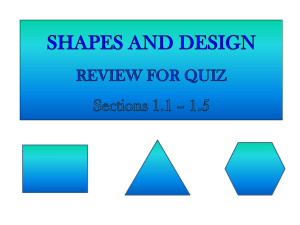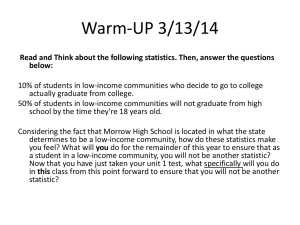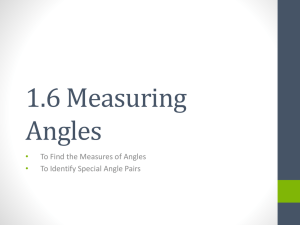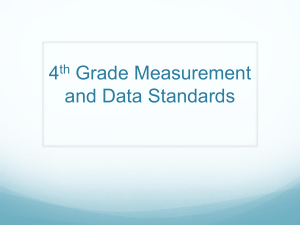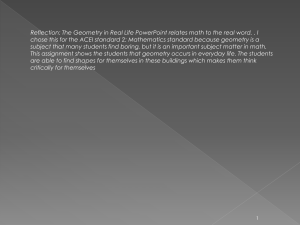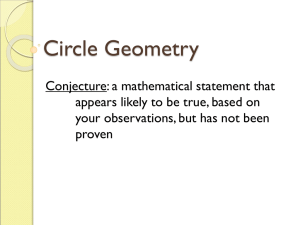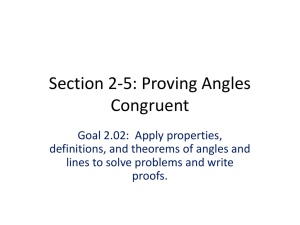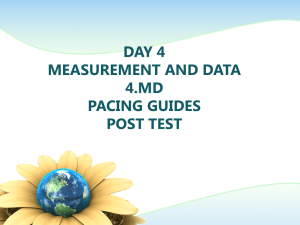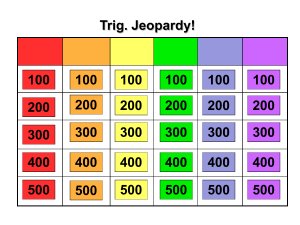Chapter 7x
advertisement
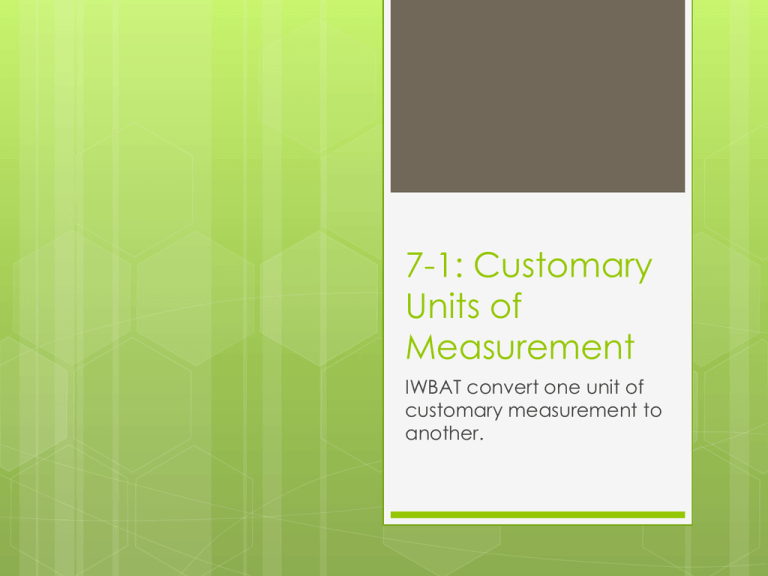
7-1: Customary Units of Measurement IWBAT convert one unit of customary measurement to another. Customary Units Length Weight 1 foot (ft) = 12 inches (in) 1 yard (yd) = 36 inches 1 pound (lb) = 16 ounces Capacity 1 cup (c) = 8 fluid ounces (fl oz) 1 pint (pt) = 2 cups 1 yard = 3 feet 1 quart (qt) = 2 pints 1 mile (mi) = 5,280 feet 1 mile = 1,760 yards 1 ton (T) = 2,000 pounds 1 gallon (gal) = 4 quarts Examples 1) 36 ft = ____ yd Going from feet to yards, you divide by 3 36 ÷ 3 12 36 ft = 12 yd 2) 36 ft = _____ in Going from feet to inches, you multiply by 12 36 ∙ 12 432 36 ft = 432 in 3) 20 oz = _______ lb 1 4) 212 qt = _____ pt Going from ounces to pounds, you divide by16 Going from quarts to pints, you multiply by 2 20 16 212 ∙ 2 1 1 4 16 43 2 ∙ 2 1 1 1 4 43 1 20 oz = 1 4 lb 1 212 qt = 43 pt 5) 9 yd 2 ft = _____ in Convert yards to inches, then feet to inches. Add. 1 6) 1 4 𝑇 = ____ lb Going from tons to pounds, you multiply by 2000 1 1 ∙ 2000 4 9 𝑦𝑑 ∙ 36 𝑖𝑛 324 5 2000 ∙ 4 1 2 𝑓𝑡 ∙ 12 𝑖𝑛 24 2500 324 + 24 348 9 yd 2 ft = 348 in 1 14 𝑇 = 2500 𝑙𝑏 7-2: Metric Units of Measurement IWBAT convert one unit of metric measurement to another. Metric Units Based on powers of 10 Use as universal measurement of science Rest of the world uses this system Stair Conversion Using the Stairs 1) 1,600 m = ____ km Moves up 3, move decimal to the left three times. 1,600 m = 1.6 km 2) 2.05 m = _____ cm 3) 4 kg = ______ g Moves down 2, move decimal to the right twice. Moves down 3, move decimal to the right three times. 2.05 m = 205 cm 4 kg = 4,000 g Examples 1) 30 kL = ____ L 30 kL = 30,000 L 4) 2,500 mm= ____ m 2) ____ kL = 4,250 L 4.25 kL = 4,250 L 3) ____ dm = 1 m 10 dm = 1 m 2,500 mm = 2.5 m 7-3: Converting Between Measurement Systems IWBAT convert units between the customary and metric systems of measurement. Customary and Metric Unit Equivalents Customary and Metric Unit Equivalents Length Weight and Mass Capacity 1 in = 2.54 cm 1 oz ≈ 28.35 g 1 L ≈ 1.06 qt 1 m ≈ 39.37 in 1 kg ≈ 2.2 lb 1 gal ≈ 3.79 L 1 m ≈ 1.09 yd 1 metric ton (t) ≈ 1.102 tons (T) 1 mi ≈ 1.61 km Converting Use proportions in correlation with the conversion chart 7-4: Spatial Reasoning IWBAT use spatial reasoning to solve problems. 7-5: Classifying and Measuring Angles IWBAT draw, measure, and classify angles. Parts of an Angle Angles are made up of two rays (sides) and one vertex (corner) How wide or narrow an angle is, is its measurement (in degrees) Types of Angles Right Angle = Exactly 90° Obtuse Angle = Greater than 90°, Less than 180° Acute Angle = Less than 90°, Greater than 0° Straight Angle = Exactly 180° Congruent Angels = Angles that have the same measure Classify the Angle Drawing Angles Use 1. 2. Identify the type of angle Use protractor to draw straight lines and to measure degrees. a) 3. a protractor Depending on the type of angle, you will use a specific side of the protractor Draw arrows at the end of your lines so that they are rays Measuring Angles Identify they type of angle This will determine which side of the protractor to read from Line up vertex with the central point of the protractor You may have to extend the rays to go beyond the protractor Read the degree measurement on the protractor 7-6: Angle Pairs IWBAT find the measure of an unknown angle from its relationship to other angles Types of Angle Pairs Vertical Angles – Angles that share a vertex, but have no sides in common. They are congruent. Adjacent Angles – Two angles that share a common side and vertex. Supplementary Angles – Two angles with the sum of 180° Complementary Angles – Two angles with the sum of 90° Finding angle measures using angle relationships Choose the right relationship that will work with the angle measure you’re looking for. Vertical angles Straight lines Corners 7-7: Triangles IWBAT classify and draw triangles, and find missing angles in triangles. Triangles Classification Triangles Classification Finding Missing Angles All triangles have a total of 180° If you are missing an angle, find the sum of the given angles and subtract from 180° Drawing Angles Use your protractor! Use a ruler! 7-8: Quadrilaterals IWBAT classify and find the missing angles of quadrilaterals. Types of Quadrilaterals Finding Missing Angles All quadrilaterals have a total of 360° Find the sum of the given angles and subtract it from 360° 7-9: Make a Table IWBAT make a table to solve a problem. 7-10: Transformations IWBAT identify translations, rotations, and reflections of two-dimensional figures. Translation, Rotation, and Reflection Translation (slide) Rotation (Turn) Reflection (mirror) Line Symmetry 7-11: Using Time Zones IWBAT use logical reasoning to solve problems involving time zones. US Time Zones
